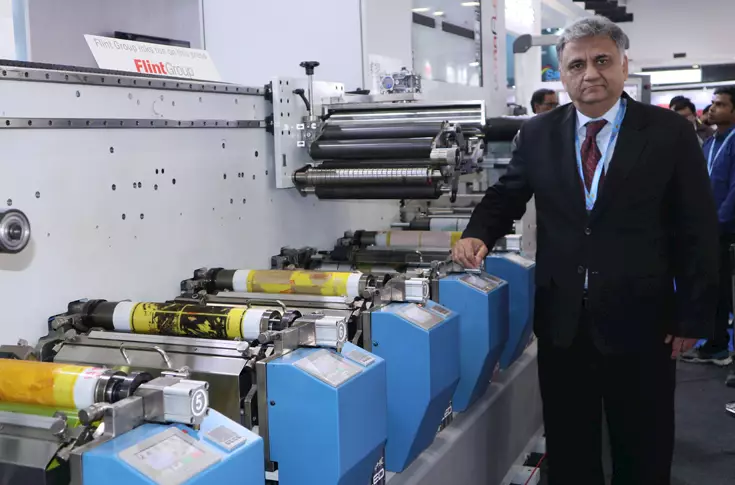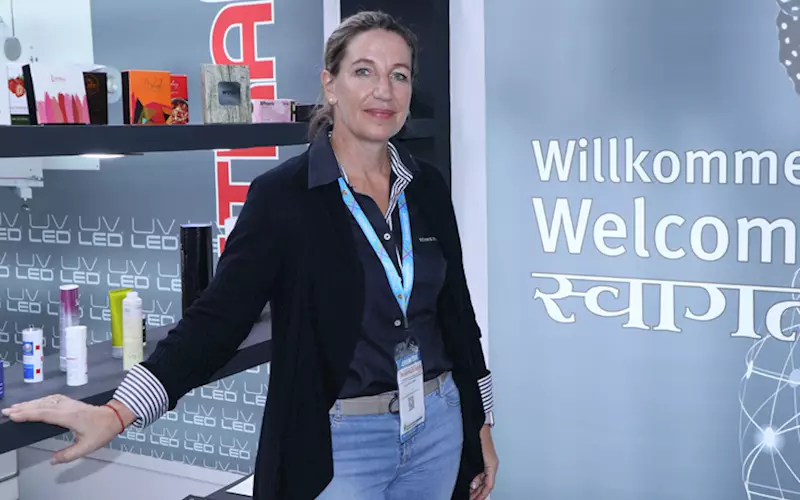Online coating is the best solution for long-run jobs
Noel D’Cunha and Rahul Kumar catch up with Karin Paldanius of Schmid Rhyner and Abhay Datta of UV Graphic Technologies at the 14th edition of PrintPack India
06 Feb 2019 | By Noel D'Cunha
PrintWeek India (PWI): What’s your agenda to be at PrintPack India 2019?
AbhayDatta (AD): Schmid Rhyner is a Swiss manufacturer of speciality coatings related to the packaging industry. It manufactures coatings for security jobs and currency notes too. Schmid Rhyner is at PrintPack India to showcase its range of speciality coatings. Leading packaging printers like Parksons Packaging, TCPL, ITC and others are using these coatings. These coatings have special formulation and are not easy to find. UV Graphic Technologies and SAM Printech represent Schmid Rhyner in India.
Who are you competitors? Actega?
Karin Paldanius (KP): Actega is a big player in water-based coating. We would be the counterpart in UV coatings. So that would be a difference. We do some water-based coatings but only specialised. Our coatings make packaging products attractive; they have anti-counterfeit capability and follow all the regulations. In our country, we have to produce coatings according to Swiss ordinance — low migration coating for indirect food packaging.
PWI: When you talk about coating, most packaging printers are going for multicolour presses with coatings. In terms of its running on a printing presses, how easy is it? Can printers do it in one pass?
KP: It all depends on what you want to achieve. You want to use conventional ink on press and want to do spot UV high gloss on top of it then you have to put premier to seal the conventional inks. If you do not follow that then you would not be able to do that in single pass. It is good to have an offline coating machine. Or you can go for retrofit machine where you can put UV directly on machine.
PWI: What is the acceptance in terms of offline and online coating system? Which is easier to do?
AD: Around three to four decades ago, all equipment were offline. Nowadays, printers are opting for online coatings. After supplying more than 220 offline coating machines to the industry, our sale is decreasing. Later, regulations came and printers started asking for drip-off and other coatings. They are using retrofitted two-colour presses for special coatings. Thus, printers could achieve special coatings on a very economical price. If you talk about the cost of this machine, then it is one fifth of the cost offered in Europe.
In India, we are converting two-three such machines per month. The demand for multi-coating is growing. Recently, I converted a four-colour printing press into one offset printing unit and two coating unit.
PWI: Which is better, online or offline?
AD: If it’s a long and repetitive job and you are capable of doing online coating then online is the best solution. But in online, getting the right texture, right balance and makeready take time. Suppose, it takes an hour time to set up, then it is a downtime for the machine which nobody calculates.
Now comes the finishing part. I feel offline finishing is better. In offline, you have time to balance and stabilise. And you have plenty of flexibility. Some coatings come out well when you do it offline because you gave them time to flourish. Most printers have both online and offline facilities.
PWI: You talked about drip off, how much it is popular in Europe?
KP: Drip-off is not much popular in Europe. Now, no one can afford an ink station for a coating station.

PWI: Why is it popular in India?
AD: It all depends on the culture of the geography. In China, for example, you will find most of the things are in gold and red. In Europe, it’s not like that. In India, gloss was in demand. Now, it is matte and gloss and special effects. It’s all about creativity. Every brand owner wants visibility. New the trend is varnish with glitter. People are doing this for two reasons — to enhance the product and to save the product from counterfeiting. It is difficult for a common printer to do it.
Schmid Rhyner manufactures silver ink and it is the best and expensive. It is substitute of metallised board.
KP: When we launched soft feel, everyone was after it. Few years ago, I came to India and everyone was impressed with soft feel and later matte. But now, soft touch is a coating we are selling well in India. Few brands have already announced that they will not use metalised boards because of recycling issues. When they move out from metalised sheets then they have to create some shiny part on the pack and for that first they can use silver and later print with other inks. Recycling of that printed sheet will be not an issue.
PWI: You spoke about regulations but we, in India, have not as many. Does it make easy for sale?
KP: We don’t use anything which is harmful for human being and packaged material. From ingredients to the final products, we follow the same parameters. India is a big market for us and we are ready with our low-migration coatings. Low-migration never means low odour. It confuses people. Low-odour is a standard UV coating. Low-migration is can be directly used for indirect packaging. That is a good opportunity for us because we are working on that for many years.
PWI: In terms of solutions, do you have something for corrugation market?
AD: As it’s low bulk and porous, UV doesn’t suit corrugation. It can be used in laminated board and LWC but in Kraft and virgin Kraft, it has very limited scope. Two years ago, Samsung came with the idea UV for Kraft but the fizzled out.
PWI: Is it possible to use the UV and LED UV coatings online in one go?
AD: Yes. It can be done and we are showcasing it during the show. We have multi wavelength dryer. With a single lamp, you can cure both UV and LED UV. In the exhibition, we are displaying it on a narrow-web press.
The price of LED UV coatings is double than the price of UV coatings. People want to use LED because of energy cost saving, where the cost of power doesn’t justify the cost of raw material.
For short-run jobs, LED UV coatings may make sense but if someone is using 20 kg LED UV coating per day, then it does not make any sense. We were the first company to offer the combination of UV and LED UV coatings.
PWI: All you products are imported for the moment. Any plan to establish a plant in India?
KP: We have only one manufacturing unit is Switzerland. Four months ago, we have established a mixing and blending centre in South East Asia.












 See All
See All